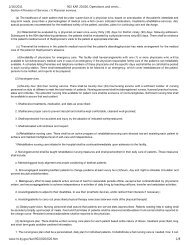State Regulations Pertaining to Dietary Sanitation & Environmental ...
State Regulations Pertaining to Dietary Sanitation & Environmental ...
State Regulations Pertaining to Dietary Sanitation & Environmental ...
You also want an ePaper? Increase the reach of your titles
YUMPU automatically turns print PDFs into web optimized ePapers that Google loves.
(p) All work surfaces shall be cleaned and sanitized after each use.<br />
(q) All dishes, utensils and glassware shall be in good repair, cleaned and sanitized after each use<br />
and properly s<strong>to</strong>red.<br />
(r) All food service equipment shall be kept clean and maintained according <strong>to</strong> manufacturer’s<br />
guidelines.<br />
(s) If soiled linen is transported through food service areas, the linen shall be in an impervious<br />
container.<br />
(t) Garbage or trash in the kitchen area shall be placed in lined containers with covers.<br />
(u) All nursing home personnel involved in the preparing and serving of food shall wash their<br />
hands and exposed portions of their arms with liquid soap and running water before handling or<br />
serving food.<br />
(v) Regularly scheduled training programs including sanitation and safety shall be made available<br />
<strong>to</strong> personnel. Information as <strong>to</strong> the content and length of this training shall be documented and kept<br />
in employee records.<br />
Source. #9856-A, eff 1-26-11<br />
He-P 803.25 <strong>Sanitation</strong>.<br />
… (c) A supply of potable water shall be available for human consumption and food preparation.<br />
(d) A supply of hot and cold running water shall be available at all times and precautions such as<br />
temperature regulation shall be taken <strong>to</strong> prevent a scalding injury <strong>to</strong> the residents.<br />
(e) Hot water shall be of a high enough temperature <strong>to</strong> ensure sanitation and food safety when used<br />
for laundry and food preparations, as required in the AIA “Guidelines for Design and Construction<br />
of Health Care Facilities,” Nursing Facilities chapter, 2006 edition, and summarized as follows:<br />
… (2) 120 degrees Fahrenheit for dietary areas, except that provisions shall be made <strong>to</strong> provide 180<br />
degrees Fahrenheit rinse water at the warewasher, which may be by separate booster, unless a<br />
chemical rinse is provided; and<br />
…(g) Cleaning solutions, compounds and substances considered hazardous or <strong>to</strong>xic materials, as<br />
defined in RSA 147-A:2, VII, shall be distinctly labeled and legibly marked so as <strong>to</strong> identify the<br />
contents and s<strong>to</strong>red in a place separate from food, medications and program supplies.<br />
(h) Toxic materials shall not be used in a way that contaminates food, equipment or utensils or in<br />
any way other than in full compliance with the manufacturer’s labeling.<br />
(i) Only individuals authorized under RSA 430:33 may apply pesticides, as defined by RSA 430:29,<br />
XXVI, for rodent or cockroach control in food s<strong>to</strong>rage, food preparation or dining areas.<br />
(j) Solid waste, garbage and trash shall be s<strong>to</strong>red in a manner <strong>to</strong> make it inaccessible <strong>to</strong> insects,<br />
rodents, outdoor animals and nursing home pets.<br />
Page 59 of 74



